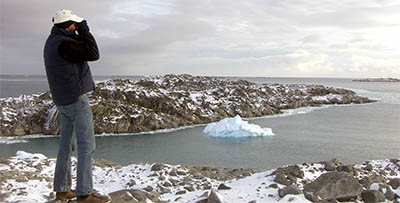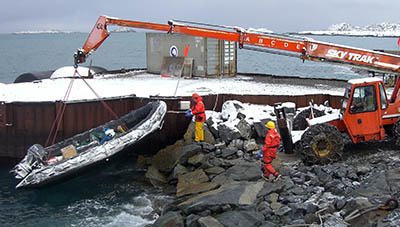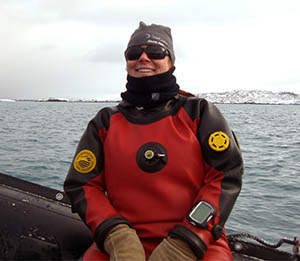
Scuba diving is a central part of our research here. We call it "Dive Ops" which is short for Diving Operations. All our experimental manipulations on this project are done in the lab but since the organisms we are studying live along the bottom of the ocean (described then as benthic organisms), Dive Ops are critical in order to collect them and their food. Today Julie and I needed to dive to collect food for the amphipods (shrimp-like animals) that she is working with in the lab and also some more amphipods for upcoming experiments.
It has been stormy the last few days and so this was the first day in three that we have been able to get out. Every morning that we need to dive and I think that we may be able to with the weather and seas, I head down to the station pier area to look at the swell (waves) and then walk up to the top of the small hill that the station is on where I can look out and see most of the islands that we would want to dive at. With binoculars I can get an idea of what the seas are like around them, which is what I'm doing in the photo at the top.

At our group meeting at 8:00 we discuss the plans for the day including both what has to be done in the lab (which always includes a lot of water chemistry monitoring every day in the experiments) and what dive collection needs we have. It was decided that heading out for a dive around 10:00 would work for everyone.
In addition to the divers, two dive "tenders" need to be in the boat to help the divers before and after the dive and to operate the boat before, during, and after a dive. Today's tenders were to be Maggie and volunteer tender Jon Olander. Jon is the station's hazardous waste specialist who is in charge of making sure that all lab and other wastes are properly packaged up and sent back to the US for processing and disposal.
Most days, we have someone from the station staff like Jon volunteering to be one of the two tenders. It is a great way for them to get off station and assist with science for a couple hours, and it allows our project to have one more person back in the lab tending to experiments. We will probably have a future post about what it is like to be a dive tender.
Between the 8:00 meeting and 10:00 departure, Julie and I got out to the dive locker between water chemistry measurements to prepare our dive gear. Because of the bad weather, Hannah Gray, the Boating Coordinator/Resident Marine Technician, had pulled our dive Zodiac boat from the water. So as Julie and I got our gear together we took it out and put it in the boat while it was still on land. That way, instead of having to load the boat in the water, all the tenders had to do was help Hannah launch the boat. The photo above on the left is Maggie and Jon helping Hannah, who is driving the Sky Trak tractor, launch the boat.
About 9:40 I headed up to our dorm room to get into my polypropylene underwear. I wear several layers on my torso and one mid-weight layer on my legs. Plus toasty warm wool socks with a polypro sock liner. Then I headed down to the dive locker to get into my really thick main dive underwear. It is a lot like a wearable sleeping bag. The main underwear with the underlying polypro is what keeps us warm. On top goes a dry suit that really does not provide a lot of insulation by itself but keeps all that toasty underwear dry so that it can.

A few years ago Kate and Maggie made a great, funny video of Kate getting suited up in the dive locker before she and I headed out for a dive. You can see it imbedded here, above on the right. It has had over 55,000 views on YouTube, so a lot of people have enjoyed it. Although Kate and Maggie were joking around a bit during it, it is a very good representation of what we do to get ready right before a dive.
With the boat in the water and ready to go, Julie and I, now all suited up, walked down from the dive locker and the four of us headed out to Hermit Island for our first of two short collecting dives. The photo to the left is of Julie as we were leaving station. We plan to have a future post about the Dive Ops process as we get to the dive site and into the water. Until then, please send any comments or questions to